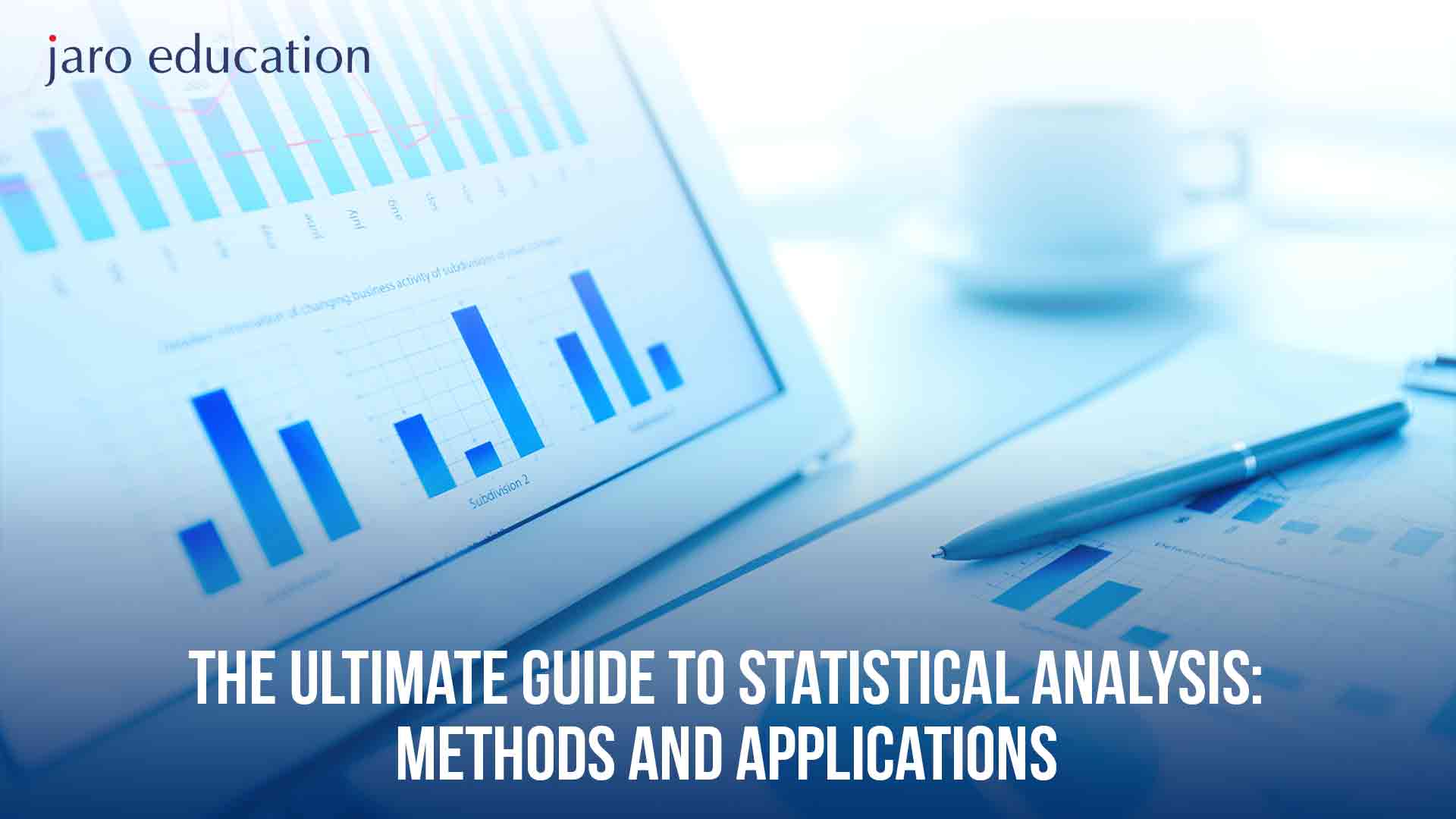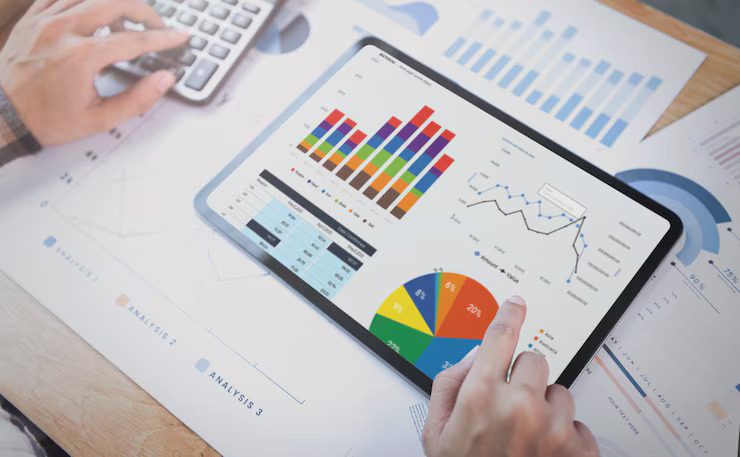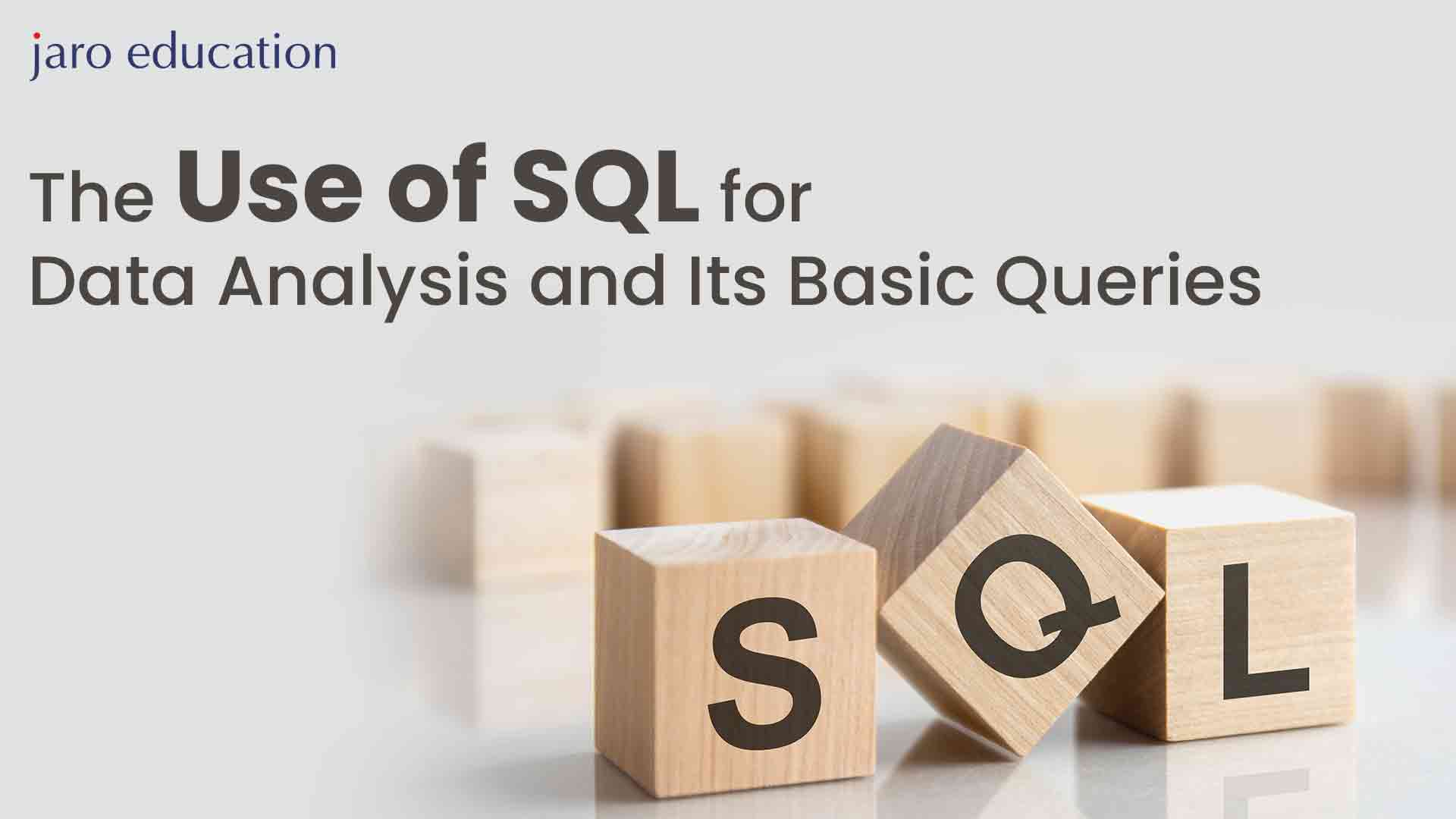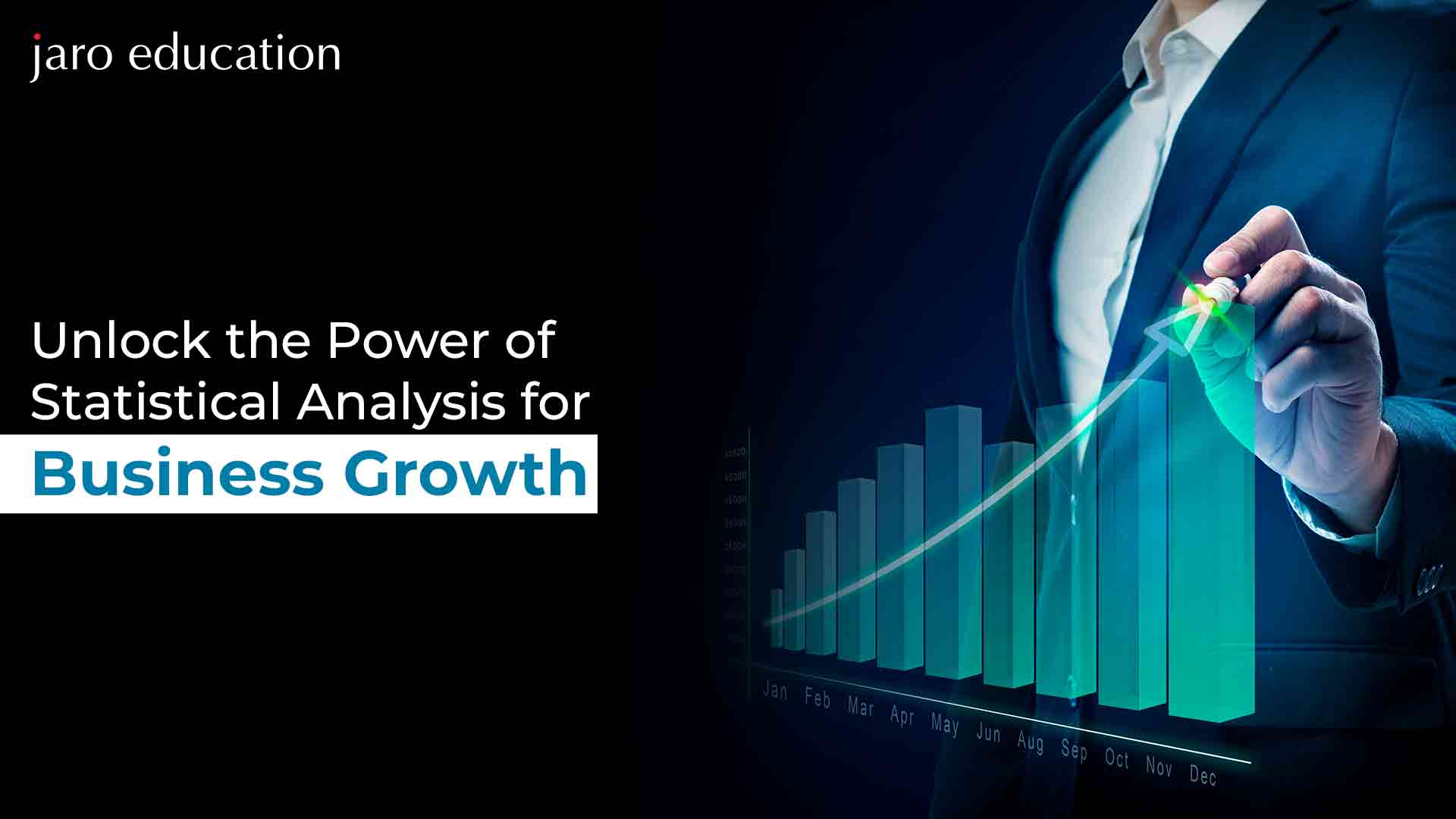The Ultimate Guide To Statistical Analysis: Methods And Applications
Table of Contents

- jaro education
- 4, August 2024
- 5:30 pm
In the world of big data, statistical analysis has become a vital component of decision-making processes among all businesses. From finance to the healthcare industry, the ability to effectively understand data can lead to substantial growth and higher efficiencies.
Thus, this blog aims to provide a complete understanding of statistical methods and applications that can help you to navigate the complexity of data interpretation.
What is Statistical Analysis?
Collecting, organising, interpreting, and presenting data are all the basic components of statistical analysis. The main purpose is to identify patterns and trends that can help in decision-making. Statistical Analysis is majorly divided into two categories – descriptive and inferential statistics. What are these? Let’s delve into each of them and get insight into them.
Types of Statistics Analysis
The most common statistical analysis
1. Descriptive Statistics
Descriptive statistics are used to summarize and describe a dataset’s prime features. They provide short summaries of the sample and the measurements. Common descriptive statistics include the following:
- Measures of Central Tendency – It includes the mean (average), median (middle value), and mode (most common value). They assign a central value to the data.
- Measures of Dispersion – Components such as variance, range, and standard deviation, describe the spread or variability of data.
- Graphical Representations – Histograms, bar charts, and scatter plots are examples of charts and graphs that can help you visualise data.
2. Inferential Statistics
Inferential statistics extend beyond the data at hand. It involves making predictions or inferences about a population using a sample. The key concepts include:
- Hypothesis Testing – This involves formulating an assumption (the hypothesis) and then applying statistical tests to see if the evidence supports that assumption. Common tests include ANOVA, t-tests, and chi-square tests.
- Confidence Intervals – These are a set of values that are most included in the population parameter. They provide a measure of the accuracy of an estimate.
- Regression Analysis – This method determines the association between variables. Multiple regression involves various independent variables, whereas simple linear regression involves only one dependent variable.
Now that you are well aware of what types of statistical techniques are available, let’s move ahead with understanding the methods that are commonly used across industries to derive valuable insights.
Widely Popular Statistical Methods
Industries use various statistical methods to derive relevant data insights. Following are some of the widely used methods.
Chi-Squared Test
The chi-square test is used to determine the association between category variables. It determines whether observed frequencies in data deviate from expected frequencies.
T-test
A t-test is used to compare the two groups’ means. It helps to determine whether the differences between groups are statistically significant. T-tests are classified into two types: independent t-tests, which compare two different groups, and paired t-tests, which compare the same group at different times.
Analysis of Variance (ANOVA)
ANOVA method is used to compare three or more groups. It assists in determining whether at least one group’s mean differs from the others. Variations have one-way ANOVA (one independent variable) and two-way ANOVA (two independent variables).

Regression Analysis
Regression analysis imitates the relationship between a dependent variable and one or more independent variables. It aids in forecasting outcomes and comprehending relationships. There are three types: linear regression, logistic regression, and multiple regression.
Correlation
Correlation assesses the strength and direction of a link between two variables. The correlation coefficient (r) runs from -1 to 1, with -1 representing a perfect negative correlation, 0 indicating no association, and 1 indicating a perfect positive correlation.
New-age Statistical Methods
In today’s world, many new statistical methods have emerged. Some of the top ones are as follows:
Factor Analysis
Factor analysis is a technique for reducing data dimensionality. It groups variables into factors to identify underlying correlations. This strategy is widely utilized in psychology and the social sciences to find underlying notions.
Cluster Analysis
Cluster analysis classifies things into groups based on their properties. It aids in detecting natural groupings in data, which is useful in market segmentation, image processing, and bioinformatics.
Time-Series Analysis
Time series analysis examines data points collected or recorded at defined time periods. It is used to recognize trends, seasonal patterns, and cyclical behaviour to analyse data. ARIMA (Auto-Regressive Integrated Moving Average) and Exponential Smoothing are two commonly used approaches.
Survival Analysis
Survival analysis is used to evaluate time-to-event data. It predicts the time until an event of interest occurs, such as equipment failure or patient survival time. The Cox proportional hazards model and Kaplan-Meier estimator are both popularly used approaches.
Applications of Statistical Analysis in Various Industries
Statistical analysis is used across various businesses, as it provides valuable insights that can be used to make informed business decisions. Following are some of the top industries in which it is extensively used.
Healthcare
Statistical Analysis is used extensively in the healthcare sector, to provide valuable insights that can help in enriching patient-centric services.
- Administrative Operations – Improves hospital management while minimising expenses.
- Epidemiology – Tracks the spread and patterns of diseases.
- Clinical Trials – Assess the efficacy and safety of new medicines.
- Patient-Centric Care – Predicts patient outcomes and optimises treatment methods.
Education
In the prevailing education sector, statistical analysis helps to analyse the behaviour and needs of the students to provide better quality education across all levels.
- Admissions and Enrollment – Identifies enrollment patterns and oversees admissions procedures.
- Resource Allocation – Aids in making better use of educational resources.
- Student Performance Analysis- Identifies factors that influence student achievement and results.
- Curriculum development – Helps in improving the quality of educational programs.
Finance
In the Finance sector, statistical analysis plays a crucial role in helping executives navigate the right financial path with valuable insights.
- Risk Management – Statistical Analysis helps to identify, assess, and minimise financial hazards.
- Investment Strategies – It helps in managing portfolio management and asset allocation.
- Market Analysis – This helps in market trends and customer behaviour.
- Fraud Detection – Statistical Analysis aids in identifying fraudulent and suspicious activities.
Marketing
Statistical analysis can boost the impact of marketing campaigns by deriving insights into customer’s habits, preferences and behaviour.
- Campaign Effectiveness – It helps in measuring the success of marketing initiatives.
- Customer Segmentation – Statistical Analysis helps in identifying various segments within a market to target their marketing efforts.
- Market Research – Statistical Analysis aids in gathering and assessing data about customer preferences and behaviour.
- Sales Forecasting – This type of analysis helps in predicting future sales using historical data.
Retail
The retailRetail industry can tremendously benefit from statistical analysis, as it can help to forecast customer demand, and inventory management.
- Inventory Management: Statistical Analysis helps in optimizing stock levels to meet demand without overstocking.
- Customer Behaviour Analysis: It helps to understand purchasing patterns and preferences.
- Price Optimization: It aids in setting prices based on demand, competition, and other factors.
- Personalized Marketing: Statistical Analysis helps in tailoring promotions and recommendations to individual customers.
Real-World Examples of Statistical Applications
Below are some real-world examples of when statistical analysis is used vividly across businesses.
Amazon
Focus point – Targeting and Customer Segmentation
Amazon uses statistical analysis to divide its client base into distinct groups based on purchasing habits, demographics, and browsing activities. Understanding these categories enables Amazon to:
- Personalize recommendations for each consumer, improvingso improving their buying experience.
- Develop tailored marketing initiatives to improve the effectiveness of promotions and adverts.
- Improve inventory management by forecasting demand for certain products across many consumer segments.
JP Morgan Chase
JPMorgan Chase uses statistical analysis for risk management in its financial operations. This includes applying advanced statistical models to:
- Assess credit risk by determining the chance of loan default.
- Manage market risk by assessing asset price and market conditions.
- Detect fraudulent transactions by observing strange patterns and behaviours.
Conclusion
Statistical analysis is an extremely effective technique for generating data-driven judgments. Whether you work in healthcare, business, education, environmental science, or the social sciences, understanding the principles of statistical methods and their applications will help you interpret data and develop meaningful conclusions. By mastering it through the courses offered by reputable institutions like the Post Graduate Certificate Programme in Applied Data Science & AI – IIT Roorkee.
To learn more about this course, connect with the admission experts of Jaro Education.












